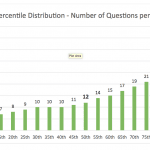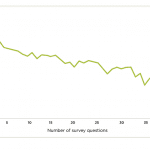How long should your survey be?
That’s a tough question to answer. There’s a lot to consider, from the survey’s topic to the people you’re surveying and the question types you’re using.
How about the typical SurveyMonkey survey? How long are those?
That answer is a little more straightforward—pretty short.
This is precisely the kind of question we survey researchers dream about, so we were excited to delve into the data to find out.
To get an idea, we looked at 2 years’ worth of surveys—more than 26,000 of them to be precise—that were conducted using SurveyMonkey Audience.

The median number of questions asked was 12, which means that 50% of surveys had 12 or fewer questions. But even going higher up the scale, 75% of surveys had 21 or fewer questions, 90% of surveys had 31 or fewer questions, and 95% of surveys had 40 or fewer questions.
The moral of the story here? You don’t need to ask a million questions to get interesting, actionable data. Most SurveyMonkey Audience customers get the information they need from a dozen or so questions.
So if you’re wondering whether it’s worthwhile to make that 5-question survey before your next school board meeting—it is! Ask the questions, check out the results, and go to your meeting armed with your data ready to make great decisions.
Here are just a few considerations to keep in mind when you’re drafting your survey.
Consider your question types
Some types of questions are easier to answer than others, which will make the survey feel shorter for respondents.
Multiple choice questions are typically the least burdensome. Open-ends and matrix questions, on the other hand, require a lot of mental work.
Thinking up and typing out your own response is much more difficult than selecting a pre-written response from a set of choices. Similarly, scrolling up and down and left and right to select a response in a large matrix can be frustrating.
Don’t forget about data quality
The longer your survey is, the more opportunities your respondents have to get tired or lazy with their answers, or—the worst—drop out of your survey altogether.
Longer surveys have lower completion rates, which means they have higher non-response bias, which is something you want to avoid. In the analysis described above, we found that surveys with 10 questions (the 50th percentile) had an average completion rate of 89%; surveys with 40 questions (the 95th percentile) had average completion rates of 79%.

Shorter surveys have higher completion rates, which means they have overall better data quality. If you’re sending a survey to your friends, family, neighbors, coworkers, or customers, you want to get as many responses as possible. Keeping your survey short helps you do exactly that.
Relevancy changes the game
If your respondents are likely to have a vested interest in the topic, longer surveys might be more feasible.
For example, if you’re doing a survey of first-time mothers about the challenges of parenting—ask away. New moms will probably have lots to say about this and will answer all the detailed questions that you may have.
But if you send the same survey to a random group of people, you probably won’t get as many results.
A good strategy is to keep surveys short if they’re going to a general audience, then follow up with more detailed questions for the people you’re most interested in hearing from.
Want more tips for writing better surveys? Check out these posts on improving survey completion rates, multiple choice and open-ended question types, and matrix questions.



